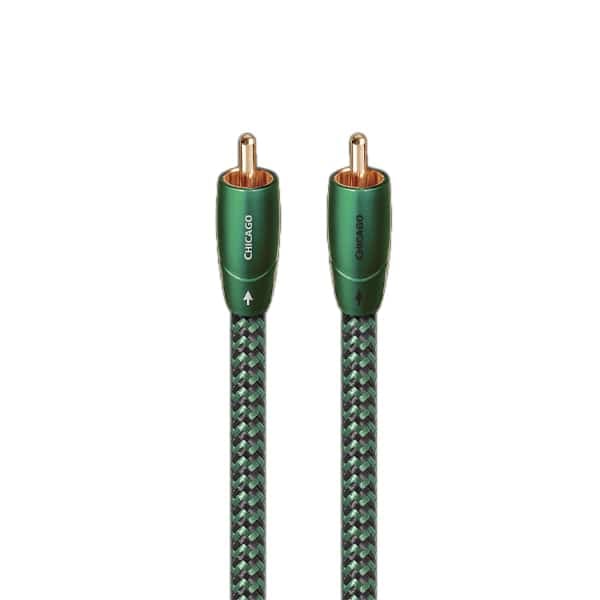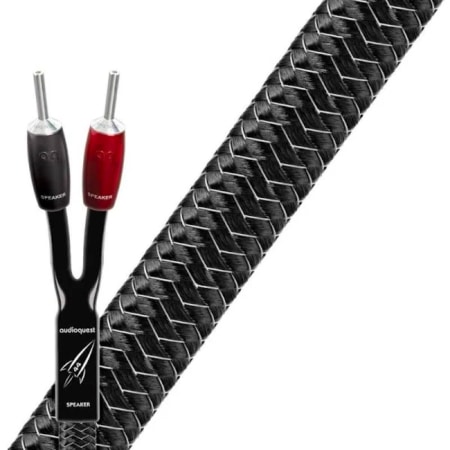Description
AudioQuest Chicago RCA to RCA Interconnect Cable
Connect audio source components to amplifiers and receivers with this AudioQuest Chicago RCA analog-audio cable, meticulously designed for exceptional performance and outstanding value. Solid Long-Grain Copper (LGC) conductors minimize distortion, Foamed-Polyethylene insulation preserves dynamic contrasts, and a Metal-Layer Noise-Dissipation efficiently dissipates high-frequency noise. The result is cleaner, clearer, more naturally beautiful music.
Solid Long-Grain Copper (LGC) Conductors
Solid Long-Grain Copper (LGC) allows a smoother and clearer sound than cables using regular OFHC (Oxygen-Free High-Conductivity) copper. Solid conductors prevent strand interaction, a major source of distortion. The surface quality is critical because a conductor can be considered as a rail-guide for both the electric fields within a conductor, and for the magnetic fields outside the conductor. LGC has fewer oxides within the conducting material, less impurities, less grain boundaries, and definitively better performance.
Direction-Controlled Conductors
All drawn metal strands or conductors have a non-symmetrical, and therefore directional, grain structure. AudioQuest controls the resulting RF impedance variation so that noise is drained away from where it will cause distortion. The correct direction is determined by listening to every batch of metal conductors used in every AudioQuest audio cable. When applicable, arrows are clearly marked on the connectors to ensure superior sound quality. For most models of AQ cable, the arrows not only indicate the direction that optimizes metal-directionality as part of Noise-Dissipation, but also indicates non-symmetrical attachment of shield and GND in order to optimize full-system performance. A fundamental aspect of AudioQuest’s multifaceted Noise-Dissipation technology, Direction-Controlled Conductors ensure induced noise is dissipated and drained properly.
Metal-Layer Noise-Dissipation
It’s easy to accomplish 100% shield coverage. Preventing captured radio-frequency interference (RFI) from modulating the equipment’s ground reference requires AQ’s Noise-Dissipation. Traditional shield systems typically absorb and then drain noise/RF energy to component ground, modulating and distorting the critical “reference” ground plane, which in turn causes a distortion of the signal. Noise-Dissipation “shields the shield,” absorbing and reflecting most of this noise/RF energy before it reaches the layer attached to ground.
Hard-Cell Foam Insulation
Hard-Cell Foam (HCF) Insulation ensures critical signal-pair geometry. Any solid material adjacent to a conductor is actually part of an imperfect circuit. Wire insulation and circuit board materials all absorb energy. Some of this energy is stored and then released as distortion. Hard-Cell Foam Insulation is similar to the Foamed-PE used in our more affordable Bridges & Falls cables, and is nitrogen-injected to create air pockets. Because nitrogen (like air) does not absorb energy and therefore does not release any energy from or into the conductor, distortion is reduced. In addition, the stiffness of the material allows the cable’s conductors to maintain a stable relationship along the cable’s full length, producing a stable impedance character and further minimizing distortion.
Double-Balanced Geometry
Specifically designed for single-ended applications, Double-Balanced Geometry offers a relatively lower impedance on the ground for a richer and more dynamic experience. While many single-ended cable designs use a single path for both the ground and the shield, Double-Balanced designs separate the two for cleaner, quieter performance.
Cold-Welded, Gold-Plated Terminations
This plug design allows for a connection devoid of solder, which is a common source of distortion. Instead of solder, the process employs a high-pressure technique. Because the ground shells are stamped instead of machined, the metal used can be chosen for low distortion instead of machinability.
KEY FEATURES:
• Noise Dissipation: The metal-layer shielding effectively absorbs and reflects radio frequency interference (RFI) before it reaches the ground layer, ensuring a cleaner signal.
• Long-Grain Copper Conductors: High-purity long-grain copper minimizes distortion by reducing interference at grain boundaries, which helps preserve audio quality.
• Hard-Cell Foamed Polyethylene Insulation: The insulation’s high air content reduces energy absorption, allowing for clearer sound transmission.









